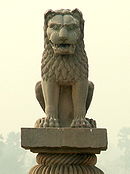- Culavamsa
-

Countries
Sri Lanka
Cambodia • Laos
Burma • ThailandHistory
Pre-sectarian Buddhism
Early schools • Sthavira
Asoka • Third Council
Vibhajjavada
Mahinda • Sanghamitta
Dipavamsa • Mahavamsa
BuddhaghosaDoctrine
Saṃsāra • Nibbāna
Middle Way
Noble Eightfold Path
Four Noble Truths
Enlightenment Stages
Precepts • Three Jewels
Outline of BuddhismThe Cūḷavaṃsa, also Chulavamsa, (Pāli: "Lesser Chronicle") is a historical record, written in the Pāli language, of the kings of Sri Lanka. It covers the period from the 4th century to 1815.
The Culavamsa was compiled over many years by Sinhala Buddhist monks[1]. It is generally considered to be a sequel to the Mahavamsa ("Great Chronicle") written in the 6th century by the monk Mahanama. The Mahavamsa and the Culavamsa are sometimes thought of as a single work (referred to as the "Mahavamsa") spanning over two millennia of Sri Lankan history.
The Culavamsa is divided into two parts. The first part begins with the 4th century arrival in Sri Lanka of a relic, said to be a tooth of Siddhartha Gautama (Lord Buddha, founder of Buddhism) and continues to the reign of King Parakramabahu the Great (1153 – 1186). While the authorship of the first part is traditionally ascribed to the monk Dhammakitti, many historians now believe it to be a collaborative effort, written by a number of monks. The second part, written over many years, continues the history of the Sri Lankan monarchy until its end in 1815, when Sri Lanka was transferred to the British Empire.
A German translation of the Culavamsa was completed by Wilhelm Geiger in 1930. This was subsequently translated into English by Mabel Haynes Bode, and the English translation was revised by Geiger.
Significance
The primary source for Parakramabahu's reign is the Culavamsa, or 'Lesser Chronicle', of Sri Lanka. The foremost translation of this work was that of William Geiger from Pali into German. In 1929 an English edition was published by Oxford University Press, translated by C.M. Rickmers.
Tradition has it that the work was compiled by the monk Dhammakitti, who Geiger regards as 'a man of literary culture...acquainted with Indian Niti literature'.[2] He regards 'the history of Parakkama [sic] as the real kernel, the main subject of the Culavamsa', much in the same way that Dutugemunu's life is the major part of the Mahavamsa.
Geiger believes that it is not possible 'to form a harmonious and credible picture of the single acts attributed to the youthful Parakkama [sic]' simply from the information presented in the Lesser Chornicle. The explanation for this lies in the writer's approach to history:
“ The explanation lies in Dhammakitti's conception of the way in which his task was to be achieved. From literary sources, from what he had read he drew an ideal picture of an Indian king. The man whose glorification was his aim must correspond to this picture. He must have all the qualities belonging to an Indian king and employ all the methods of statecraft which political science prescribes or recommends. All these individual traits the compiler combines with the data furnished by tradition, without question as to probability or improbability of these. ” — W. Geiger, The Culavamsa, 1930, IntroductionThat there is a certain amount of truth contained in the text is corroborated by numerous carvings, edicts and monuments still extant in Sri Lanka today - e.g., Parakramabahu's wars with Gajabahu and Manabharana are attested to by at least one rock-carving from this period.[3][4][5][6] Furthermore Geiger also believes that the Culavamsa 'does not consciously relate...false [information]'.[7]
See also
- History of Sri Lanka
- Buddhist texts
- Mahawamsa
Notes
- ^ Cūlavaṃsa Britannica
- ^ Introduction, The Culavamsa: Being the More Recent Part of the Mahavamsa, W. Geiger, trans. C.M. Rickmers (London 1930)
- ^ see A History of Sri Lanka, K. A. de Silva (New Delhi 2005)
- ^ Ancient Ceylon, H. Parker, (London 1909)
- ^ A Short History of Sri Lanka, H. W. Codrington (London 1929)
- ^ H. C. P. Bell, Report on Kegalle District, (1892), p. 72 - 73
- ^ W. Geiger, Culavamsa, Introduction
Sri Lanka topics History TimelinePrehistory · Dipavamsa · Mahavamsa · Culavamsa · Vijaya · Portuguese Ceylon · Dutch Ceylon · British Ceylon · Kandyan Wars · Uva Rebellion · Matale Rebellion · Independence movement · Dominion of Ceylon · Civil WarkingdomsKingdom of Tambapanni · Kingdom of Upatissa Nuwara · Anuradhapura Kingdom · Kingdom of Polonnaruwa (Kingdom of Jaffna · Kingdom of Ruhuna) · Kingdom of Dambadeniya · Kingdom of Gampola · Kingdom of Raigama · Kingdom of Kotte · Kingdom of Sitawaka · Kingdom of KandyTopicsGovernment Politics Elections · Parliament · President of Sri Lanka (current) · Prime Minister (current) · Foreign relations · Elections · Political parties · Supreme Court · PoliceGeography LandformsExtreme points · Mountains · Islands · Rivers · Waterfalls
EnvironmentEconomy Central Bank of Sri Lanka · Sri Lankan rupee · Colombo Stock Exchange · Agriculture · Ceylon tea · Gems · Communications · Power stations · Companies · Banking · Insurance · Standard of living · Tourism · Buildings · Transportation (Airports · A-Grade Highways · Passenger vehicles · Railroads)Society Crime · Demographics (Ethnic groups in Sri Lanka) · Education (schools · universities) · Health care · Languages (Sri Lankan English) · Media · People (List of Sri Lankans) · Public holidays · Religion (Buddhism · Hinduism · Islam) · Social class · Sports (Cricket · Rugby) · BirthCulture Architecture (Ancient architecture / constructions (stupas)) · Television / Cinema · Cuisine · Dance · Folklore · Fashion · Literature · Music · Scouting · World Heritage Sites · Poetry · Radio · Visual artsSymbols Other topics Human rights · ResearchPortal Categories:- History of Sri Lanka
- Religion in Sri Lanka
- Sri Lankan literature
- Pāli Buddhist texts
- Sri Lankan chronicles
Wikimedia Foundation. 2010.
